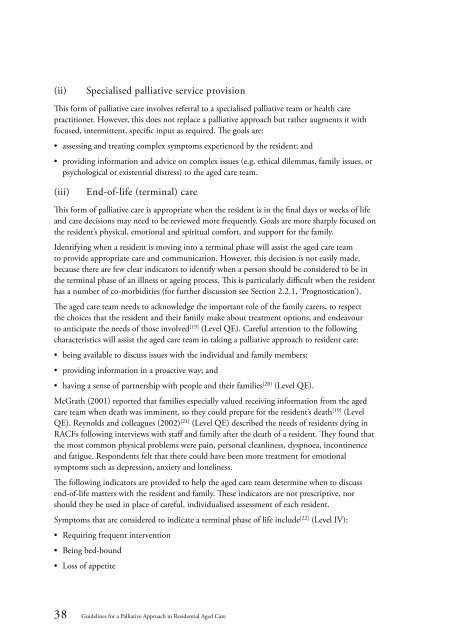Guidelines for a Palliative Approach in Residential Aged Care
Guidelines for a Palliative Approach in Residential Aged Care
Guidelines for a Palliative Approach in Residential Aged Care
Create successful ePaper yourself
Turn your PDF publications into a flip-book with our unique Google optimized e-Paper software.
(ii)<br />
Specialised palliative service provision<br />
This <strong>for</strong>m of palliative care <strong>in</strong>volves referral to a specialised palliative team or health care<br />
practitioner. However, this does not replace a palliative approach but rather augments it with<br />
focused, <strong>in</strong>termittent, specific <strong>in</strong>put as required. The goals are:<br />
• assess<strong>in</strong>g and treat<strong>in</strong>g complex symptoms experienced by the resident; and<br />
• provid<strong>in</strong>g <strong>in</strong><strong>for</strong>mation and advice on complex issues (e.g. ethical dilemmas, family issues, or<br />
psychological or existential distress) to the aged care team.<br />
(iii)<br />
End-of-life (term<strong>in</strong>al) care<br />
This <strong>for</strong>m of palliative care is appropriate when the resident is <strong>in</strong> the f<strong>in</strong>al days or weeks of life<br />
and care decisions may need to be reviewed more frequently. Goals are more sharply focused on<br />
the resident’s physical, emotional and spiritual com<strong>for</strong>t, and support <strong>for</strong> the family.<br />
Identify<strong>in</strong>g when a resident is mov<strong>in</strong>g <strong>in</strong>to a term<strong>in</strong>al phase will assist the aged care team<br />
to provide appropriate care and communication. However, this decision is not easily made,<br />
because there are few clear <strong>in</strong>dicators to identify when a person should be considered to be <strong>in</strong><br />
the term<strong>in</strong>al phase of an illness or age<strong>in</strong>g process. This is particularly difficult when the resident<br />
has a number of co-morbidities (<strong>for</strong> further discussion see Section 2.2.1, ‘Prognostication’).<br />
The aged care team needs to acknowledge the important role of the family carers, to respect<br />
the choices that the resident and their family make about treatment options, and endeavour<br />
to anticipate the needs of those <strong>in</strong>volved [19] (Level QE). <strong>Care</strong>ful attention to the follow<strong>in</strong>g<br />
characteristics will assist the aged care team <strong>in</strong> tak<strong>in</strong>g a palliative approach to resident care:<br />
• be<strong>in</strong>g available to discuss issues with the <strong>in</strong>dividual and family members;<br />
• provid<strong>in</strong>g <strong>in</strong><strong>for</strong>mation <strong>in</strong> a proactive way; and<br />
• hav<strong>in</strong>g a sense of partnership with people and their families [20] (Level QE).<br />
McGrath (2001) reported that families especially valued receiv<strong>in</strong>g <strong>in</strong><strong>for</strong>mation from the aged<br />
care team when death was imm<strong>in</strong>ent, so they could prepare <strong>for</strong> the resident’s death [19] (Level<br />
QE). Reynolds and colleagues (2002) [21] (Level QE) described the needs of residents dy<strong>in</strong>g <strong>in</strong><br />
RACFs follow<strong>in</strong>g <strong>in</strong>terviews with staff and family after the death of a resident. They found that<br />
the most common physical problems were pa<strong>in</strong>, personal cleanl<strong>in</strong>ess, dyspnoea, <strong>in</strong>cont<strong>in</strong>ence<br />
and fatigue. Respondents felt that there could have been more treatment <strong>for</strong> emotional<br />
symptoms such as depression, anxiety and lonel<strong>in</strong>ess.<br />
The follow<strong>in</strong>g <strong>in</strong>dicators are provided to help the aged care team determ<strong>in</strong>e when to discuss<br />
end-of-life matters with the resident and family. These <strong>in</strong>dicators are not prescriptive, nor<br />
should they be used <strong>in</strong> place of careful, <strong>in</strong>dividualised assessment of each resident.<br />
Symptoms that are considered to <strong>in</strong>dicate a term<strong>in</strong>al phase of life <strong>in</strong>clude [22] (Level IV):<br />
• Requir<strong>in</strong>g frequent <strong>in</strong>tervention<br />
• Be<strong>in</strong>g bed-bound<br />
• Loss of appetite<br />
38 <strong>Guidel<strong>in</strong>es</strong> <strong>for</strong> a <strong>Palliative</strong> <strong>Approach</strong> <strong>in</strong> <strong>Residential</strong> <strong>Aged</strong> <strong>Care</strong>
















